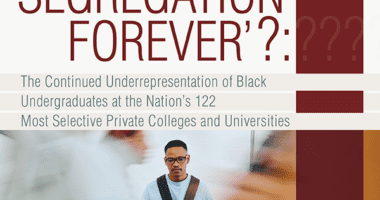Reports reveal colleges with the biggest, smallest gaps in minority graduation rates in the U.S.
WASHINGTON (August 9, 2010) Two reports released today by The Education Trust – Big Gaps, Small Gaps: Some Colleges and Universities Do Better Than Others in Graduating African-American Students and Big Gaps, Small Gaps: Some Colleges and Universities Do Better Than Others in Graduating Hispanic Students – dig beneath national college-graduation averages and examine disaggregated six-year graduation rates at hundreds of the nations public and private institutions.
Even though 57 percent of all students who enroll earn diplomas within six years, the graduation rates for different groups of students are vastly different. Nationally, 60 percent of whites but only 49 percent of Latinos and 40 percent of African Americans who start college hold bachelors degrees six years later.
”These averages mask important differences between institutions,” said Kati Haycock, president of The Education Trust. “Graduation rates at individual institutions tell a range of stories – some of smashing success – which should be studied deeply and replicated widely. Unfortunately, there are others of shocking irresponsibility. The lesson of all of these stories is: What colleges do for students of color powerfully impacts the futures of these young people and that of our nation.”
Using several years of data from College Results Online – a unique Web-based tool that allows the public to view college graduation rates by race, ethnicity, and gender for four-year institutions across the country – these reports highlight institutions that are doing well and expose those that are missing the mark on graduation equity, some of them by miles:
- At Wayne State University in Detroit, for example, fewer than one in ten African Americans graduate within six years. For white students at Wayne State, the success rate is more than four times higher.
- The success rate among Hispanic students attending City University of New Yorks Brooklyn College is 34 percent, compared with a 53 percent graduation rate for white students.
These colleges are hardly alone.
- At nearly two-thirds of the colleges and universities in the study, fewer than half the African-American students emerge with a degree.
- And though the vast majority of Latino students in the study entrust their futures to public colleges and universities, more than 60 percent of the institutions they attend graduate fewer than half their Latino students in six years.
”We did uncover some large gaps in student success rates and low graduation rates for students of color. But it would be wrong to assume that these gaps are inevitable or immutable,” said Mamie Lynch, higher education research and policy analyst at The Education Trust and coauthor of the report. “For many of the big gap schools, we can point to an institution working with a similar student body that graduates students of color at rates similar to those of white students.”
As examples of more successful colleges, Lynch points to such schools as these:
- Old Dominion University in Virginia, where African Americans make up almost a quarter of the student population and have historically graduated at rates equal to white students. In 2008, 56 percent of African Americans at the university graduated in six years or less, exceeding the national average graduation rate for black students.
- Florida International University (FIU), where nearly two-thirds of all students are Hispanic. Completion rates among Hispanic students at FIU have outpaced those among white students in each of the past seven years.
- University of California, Riverside (UCR), which successfully graduates black, Latino, and white students. Because of its focus on data, strong leadership, and retention efforts carried out by each of the universitys colleges, the university can boast 63 percent and 67 percent graduation rates for Latino and African-American students, respectively. The success rate for white students at UCR is 62 percent.
The new reports demonstrate that similarities between schools do not necessarily result in similarities in minority graduation rates. At peer institutions – schools with comparable institutional and student characteristics – the gaps for minority student groups run the gamut from abysmal to exemplary.
At the University of Illinois at Chicago, a 22 percentage-point gap in success rates separates white and African-American students, who graduate at 52 percent and 30 percent, respectively. But at a peer institution, University of North Carolina-Greensboro, the graduation rates among black students are dramatically different. On average, 56 percent of African-American students at UNC-Greensboro graduate within six years, compared with 51 percent of white students. UNC-Greensboro Vice Provost Alan Boyette attributes the universitys equitable graduation rates to three guiding principles: (1) Student success is a part of the schools mission, (2) the cost-effectiveness of helping students graduate rather than recruiting new students, and (3) the University of North Carolinas systemwide focus on student retention and graduation goals.
The programs tied to UNC-Greensboros goals are available to all students, but many are targeted at minority and underserved populations. The programs arent there as showpieces. To the contrary, the university provost relies heavily on data to determine the success or failure of the programs. Those that dont work are discontinued, and those that do are expanded.
“Higher education institutions that place success at the heart of their mission make it a realistic goal for every student,” said Jennifer Engle, assistant director of higher education at The Education Trust and coauthor of the report. “For both moral and economic reasons, colleges need to ensure that their institutions work better for all of the students they serve.”
For more information about American public colleges and universities making the biggest gains in closing gaps that separate students, read two other Ed Trust briefs, “Top Gainers and Top Gap Closers.”
# # #









